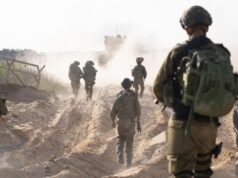Pentagon spokesman Adm. John Kirby told reporters he understood that U.S. air power wouldn’t save Kobani, but there is a “larger strategy” in place. The primary goal of the campaign is not to save Syrian cities and towns, U.S. Central Command officials said, but to go after ISIS senior leadership, oil refineries, and other infrastructure that would curb the group’s ability to operate. If the strategy is to allow ISIS to advance its murderous agenda against Kurds and others while we “plink” its leaders from above, it is a humanitarian, military, and political disaster of a strategy.
The successful Houthi power-grab in Yemen this week is important by itself, but it is also an example of what happens when the U.S. attempts to arm and train militaries that are not our own, determines who those militaries will have as enemies, fails to provide “boots” where necessary to control events on the ground, focuses on one enemy/situation to the exclusion of other relevant players, and engages in “reform” of the military’s relationship with its government at the same time. Thus, it provides perspective on other Middle East hot spots, including the unfortunate Kobani.
The U.S. has been conducting drone and air strikes in Yemen since 2002, which is slightly misleading – in 2002, there was one drone and no air strikes, and then drone/bomb silence until 2009 under the Obama administration. Since 2009, there have been 112 drone strikes and 99 air strikes. It appears that about 1,000 people have been killed: 700-900 militants, 80-plus civilians, and almost 50 “unclassified.” Statistics being notoriously unreliable, consider the political implications. The American goal was to “degrade and destroy” al-Qaeda in the Arabian Peninsula (AQAP) and preserve the Sunni Yemeni government, sitting just south of Saudi Arabia and its oil.
There were no American “boots on the ground,” except where there were.
The State Department reported that the U.S. spent $256 million in assistance to Yemen in FY2013, after more than $356 million in FY2012. In December 2013, DOD notified Congress that it planned to spend $64 million on precision strike aircraft, unmanned aerial surveillance, and training for Yemen’s national military forces.” (This despite a 2013 UN report noting that about 15% of government forces are child soldiers, which by U.S. law makes Yemen ineligible for US military assistance.)
According to the Congressional Research Service, U.S. military and intelligence personnel worked closely with the Yemeni army to train, equip, and assist ground forces in reclaiming territory seized in 2011 by AQAP militants. To some extent Yemenis succeeded in driving AQAP out of populated areas in certain southern provinces, and U.S. strikes appear to have degraded its leadership. At the same time, the report states, the U.S. attempted to “restructure” the Yemeni military to work under civilian leadership, responsive to its public.
The emphasis on the degradation of AQAP appears to have led some to overlook the other groups in opposition to the Sa’ana government, including the Houthi Shiite militiamen of the north. Houthis, by the way, use child soldiers for about 20% of their fighting forces and, according to the UN, force girls to marry militia members and then cook and carry military and other supplies.
The Houthis have been expanding control of territory since October 2013 and engaged in battle with pro-government forces in two other provinces before barging into Sa’ana this week. They faced little opposition, it seems, from the Yemeni army as they took control of the Ministry of Defense, the Central Bank, the airport, and the state television building, forcing a power-sharing arrangement on the government and announcing their anti-American credentials. A full-blown coup was averted only by Houthi political leaders who apparently decided that was enough for now – perhaps to avoid total blame if things don’t work out. In Yemen, things often don’t work out.
Starting to sound familiar?
- ISIS grabbed our attention for good reason. But the all-out U.S. effort to “degrade and destroy” it from the air leaves the butcher Bashar Assad to understand that his enemies are also America’s enemies and that the U.S. will leave him in power while it pursues ISIS. The U.S. decision to arm and train “moderate militias” is strange, actually – the Pentagon has asked for $500 million for training, but acknowledges that it hasn’t decided yet on whom to train. And even if, a big if, a fighting force can be produced in a year during which ISIS and Assad will continue fighting with trained troops and war crimes, who says it will kill its ISIS cousins if that results in protecting Assad?
- Assad’s new confidence that U.S. air strikes will degrade his enemies may in turn account for increased Hezb’allah activity against Israel’s north. Lebanese citizens are furious that Syria’s civil war has been spilling into their country. With less need to spend its Iranian assets in Syria, Hezb’allah can work to restore its eroded position at home – best done, it believes, by taking the fight to Israel. Cross-border attacks and IEDs generated by Hezb’allah have forced Israel into retaliation, making the north increasingly nervous on both sides.
- The Iraqi military, which the U.S. ceased to train in 2011 and which the Shiite government in Baghdad tried to transform into a Shiite-dominated force, is now ill-equipped to fight for its territory. The U.S. decision to create Iraqi Sunni “national guard” units to protect territory “recaptured” from ISIS sounds much like the 2007 Sunni Awakening of the surge except for two things: last time, they had the United States Marines behind and alongside them, and since our departure, Sunnis have less reason to trust us.
- And now, Kobani. The Kurdish town that had taken Iraqi refugees of all ethnicities and religions is under siege by ISIS on the ground. While the U.S. has bombed some ISIS assets, fighters are infiltrating the city making further pursuit by air impossible without large-scale civilian casualties. There are no “boots” to stop them. Turkish troops, sitting in tanks, can be seen across the border watching Kobani but not moving to its defense. Not surprising, but watching them watch disaster speaks volumes.
The viciousness of ISIS against women, children, and “apostate” Muslims will make Yemen’s troubles look simple, but Yemen was the canary in the coal mine. Now the real disaster is underway, and the U.S. remains out of touch with its origins and its path. Kobani and what it represents appear doomed – to America’s shame.





